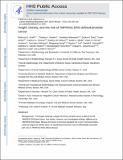Height, Obesity, and the Risk of TMPRSS2:ERG-Defined Prostate Cancer
Author(s)
Graff, Rebecca E.; Ahearn, Thomas U.; Pettersson, Andreas; Ebot, Ericka M.; Gerke, Travis; Penney, Kathryn L.; Wilson, Kathryn M.; Markt, Sarah C.; Pernar, Claire H.; Gonzalez-Feliciano, Amparo G.; Song, Mingyang; Lis, Rosina T.; Schmidt, Daniel R.; Vander Heiden, Matthew G.; Fiorentino, Michelangelo; Giovannucci, Edward L.; Loda, Massimo; Mucci, Lorelei A.; ... Show more Show less
DownloadAccepted version (131.4Kb)
Open Access Policy
Open Access Policy
Creative Commons Attribution-Noncommercial-Share Alike
Terms of use
Metadata
Show full item recordAbstract
© 2017 American Association for Cancer Research. Background: The largest molecular subtype of primary prostate cancer is defined by the TMPRSS2:ERG gene fusion. Few studies, however, have investigated etiologic differences by TMPRSS2:ERG status. Because the fusion is hormone-regulated and a man's hormonal milieu varies by height and obesity status, we hypothesized that both May be differentially associated with risk of TMPRSS2:ERG-defined disease. Methods: Our study included 49,372 men from the prospective Health Professionals Follow-up Study. Participants reported height and weight at baseline in 1986 and updated weight biennially thereafter through 2009. Tumor ERG protein expression (a TMPRSS2:ERG marker) was immuno-histochemically assessed. We used multivariable competing risks models to calculate HRs and 95% confidence intervals (CIs) for the risk of ERG-positive and ERG-negative prostate cancer. Results: During 23 years of follow-up, we identified 5,847 incident prostate cancers, among which 913 were ERG-assayed. Taller height was associated with an increased risk of ERG-positive disease only [per 5 inches HR 1.24; 95% confidence interval (CI), 1.03–1.50; Pheterogeneity ¼ 0.07]. Higher body mass index (BMI) at baseline (per 5 kg/m2 HR 0.75; 95% CI, 0.61–0.91; Pheterogeneity ¼ 0.02) and updated BMI over time (per 5 kg/m2 HR 0.86; 95% CI, 0.74–1.00; Pheterogeneity ¼ 0.07) were associated with a reduced risk of ERG-positive disease only. Conclusions: Our results indicate that anthropometrics May be uniquely associated with TMPRSS2:ERG-positive prostate cancer; taller height May be associated with greater risk, whereas obesity May be associated with lower risk. Impact: Our study provides strong rationale for further investigations of other prostate cancer risk factors that May be distinctly associated with subtypes. Cancer Epidemiol Biomarkers Prev; 27(2); 193–200. 2017 AACR.
Date issued
2017-11Department
Koch Institute for Integrative Cancer Research at MITJournal
Cancer Epidemiology Biomarkers and Prevention
Publisher
American Association for Cancer Research (AACR)
ISSN
1055-9965
1538-7755